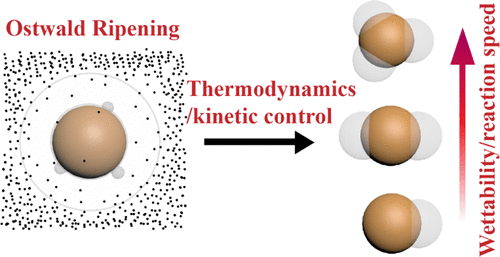当前位置:
X-MOL 学术
›
J. Phys. Chem. C
›
论文详情
Our official English website, www.x-mol.net, welcomes your
feedback! (Note: you will need to create a separate account there.)
Tuning the Valency of Heterogeneous Au–Silica Nanostructure via Controlled Ostwald Ripening Process
The Journal of Physical Chemistry C ( IF 3.3 ) Pub Date : 2018-07-31 , DOI: 10.1021/acs.jpcc.8b04237
Yi Luo 1 , Shenghao Geng 1 , Lacie Dube 1 , Jing Zhao 1, 2
The Journal of Physical Chemistry C ( IF 3.3 ) Pub Date : 2018-07-31 , DOI: 10.1021/acs.jpcc.8b04237
Yi Luo 1 , Shenghao Geng 1 , Lacie Dube 1 , Jing Zhao 1, 2
Affiliation

|
Morphology control of interfaced heterogeneous nanostructure composed of two different materials is critical for achieving desired properties of the nanostructures. With heterogeneous Au–silica system as a case study, we explored the reaction mechanism that controlled the number of overgrown silica domains on Au nanoparticle seeds. We discovered in our system that three factors dominated the overgrowth of silica on gold surface: (a) gold core size, (b) wettability of the surface of the Au core (controlled by the amount of ligands), and (c) reaction kinetics of hydrolysis of the silica precursor. In particular, the latter two played distinct roles in triggering different extents of Ostwald ripening and contributed to the symmetry breaking of the morphology of the final product from core–shell to core–satellite. Specifically, poly(acrylic acid) ligand decreased the local wettability of the Au nanoparticle surface and resulted in discrete domain growth. Adequate wetting introduced by 3-mercaptopropionic acid/cetyltrimethylammonium ligands lowered the Au–silica interface energy and stabilized the silica domain in the later growth stage. After the initial nucleation process, depending on the surface wettability and reaction kinetics, Ostwald ripening of silica was triggered by the depletion field and certain number of domains survived after the ripening process. By tuning the core size, surface wettability, and reaction kinetics, Au–silica heterogeneous structure with desired number of silica domains can be achieved. Since Ostwald ripening happens in many systems, including metal, metal oxide, and semiconductors, our findings can provide guidance to the synthesis of a wide span of heterogeneous structures.
中文翻译:

通过可控的奥斯特瓦尔德熟化工艺来调节异质金-硅纳米结构的化合价
由两种不同材料组成的界面异质纳米结构的形态控制对于实现所需的纳米结构性能至关重要。以非均相Au-二氧化硅系统为例,我们探索了控制金纳米粒子种子上过度生长的二氧化硅结构域数量的反应机理。我们在系统中发现,三个因素主导了金表面二氧化硅的过度生长:(a)金核尺寸,(b)Au核表面的润湿性(受配体数量控制)和(c)反应动力学二氧化硅前体的水解。特别地,后两者在引发不同程度的奥斯特瓦尔德熟化中起着不同的作用,并有助于最终产物的形态从核-壳到核-卫星的对称性破坏。具体来说,聚(丙烯酸)配体降低了Au纳米颗粒表面的局部润湿性,并导致离散的畴生长。3-巯基丙酸/鲸蜡基三甲基铵配体引入的充分润湿作用降低了Au-二氧化硅界面能,并在后期生长阶段稳定了二氧化硅结构域。在最初的成核过程之后,取决于表面的润湿性和反应动力学,耗尽场引发了二氧化硅的奥斯特瓦尔德熟化,并且在熟化过程后还保留了一定数量的畴。通过调节核尺寸,表面润湿性和反应动力学,可以实现具有所需数量的二氧化硅结构域的Au-SiO2异质结构。由于奥斯特瓦尔德(Ostwald)熟化发生在许多系统中,包括金属,金属氧化物和半导体,
更新日期:2018-07-31
中文翻译:

通过可控的奥斯特瓦尔德熟化工艺来调节异质金-硅纳米结构的化合价
由两种不同材料组成的界面异质纳米结构的形态控制对于实现所需的纳米结构性能至关重要。以非均相Au-二氧化硅系统为例,我们探索了控制金纳米粒子种子上过度生长的二氧化硅结构域数量的反应机理。我们在系统中发现,三个因素主导了金表面二氧化硅的过度生长:(a)金核尺寸,(b)Au核表面的润湿性(受配体数量控制)和(c)反应动力学二氧化硅前体的水解。特别地,后两者在引发不同程度的奥斯特瓦尔德熟化中起着不同的作用,并有助于最终产物的形态从核-壳到核-卫星的对称性破坏。具体来说,聚(丙烯酸)配体降低了Au纳米颗粒表面的局部润湿性,并导致离散的畴生长。3-巯基丙酸/鲸蜡基三甲基铵配体引入的充分润湿作用降低了Au-二氧化硅界面能,并在后期生长阶段稳定了二氧化硅结构域。在最初的成核过程之后,取决于表面的润湿性和反应动力学,耗尽场引发了二氧化硅的奥斯特瓦尔德熟化,并且在熟化过程后还保留了一定数量的畴。通过调节核尺寸,表面润湿性和反应动力学,可以实现具有所需数量的二氧化硅结构域的Au-SiO2异质结构。由于奥斯特瓦尔德(Ostwald)熟化发生在许多系统中,包括金属,金属氧化物和半导体,































 京公网安备 11010802027423号
京公网安备 11010802027423号